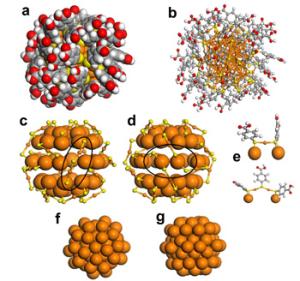Researchers Peer Into Gold Nanoclusters
DailyTech – Researchers Peer Into Gold Nanoclusters
Gold nanoparticles are widely used by researchers around the globe. Because they are stable and have defined electronic, electrochemical, and optical properties; they are useful for a great many types of work. However, until recently, how the particles’ structures were as stable as they are has been a mystery. These superatoms, often composed of gold and one or more additional elements, hid their molecular and electronic structures from scientists quite well.
Research done by a collection of universities including Georgia Tech University, Stanford University, the University of Jyväskylä in Finland, and Chalmers University of Technology in Sweden broke through the haze of the mysterious atomic clusters. Earlier work at Stanford in 2007 disproved a popular theory that secondary atoms, in this case sulfur atoms, simply sat atop a structure of pure gold, connected to multiple atoms of the core.
Instead, the organic sulfer molecules, known as thiolates, stole gold atoms from the core forming a protective cover around it attached by the thiolate-gold-thiolate bonds. This confirmed, instead, a “divide and protect” theory predicted by Hannu Häkkinen, a professor at the University of Jyväskylä, formerly of Georgia Tech.
The accumulated work has been used to predict the structures of different gold nanoclusters involving various amounts of gold atoms. At least one of these structures, a 25 gold atom cluster, has been confirmed by another group of researchers.
Further understanding the complex gold nanoparticles will aid scientists in designing custom gold nanoparticles for use in various areas of research. “We now have a unified model that provides a solid background for nanoengineering ligand-protected gold clusters for applications in catalysis, sensing, photonics, bio-labeling and molecular electronics,” Häkkinen explained.


Recent Comments